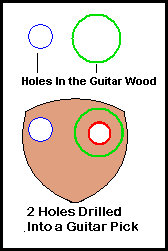Besides the electronics of rewiring, there are many choices you can make to change the appearance of the guitar as well.
For example, you can use different kinds of switches and even guitar picks .

Get a guitar pick and drill into it two small holes, the same size as the hole on the left. Place the left side switch in the hole already drilled in the guitar then place the guitar pick on that switch and secure it with the nut. (You will probably not be able to squeeze in the switch washer because of the thickness of the guitar pick). Now place the right hand switch into the guitar and tighten the switch nut onto the guitar pick. Now both switches have been firmly secured. The left switch is secured to the guitar wood and the guitar pick and the right side switch is secured only to the guitar pick but it is quite strong. I have done this many times (see the photos), and the pick is extremely secure. Don’t forget that a guitar pick is very strong and this is something you should also keep in mind when you drill into them.
These photos might give you some ideas.
![yamaha[1]](https://wp.1728.org/wp-content/uploads/2024/03/yamaha1.jpg)
![agile[1]](https://wp.1728.org/wp-content/uploads/2024/03/agile1.jpg)
The guitar on the above left is a Yamaha SBG 2000, sometimes referred to as the “Japanese Les Paul”. Like the Les Paul, it weighs a lot and has tremendous sustain. Those formidable looking pickups are DiMarzio X2N’s, the highest output pickup made by any manufacturer. Despite their incredible output, with the proper switching, you can get very bright sounds out of those X2N’s and I sometimes jokingly refer to this as my “surf guitar”. Yes there are eight switches on this guitar because I added a solo switch to the Super Seven Switching. That’s a red rocker switch for the phase switch chosen just because I like the look of it.
On the right is an Agile AL-2000 Gold-Top guitar which is an inexpensive copy of a Les Paul. In spite of its relatively low price, it is well-made and has good action. It originally came with P-90 pickups which are slightly larger versions of the traditional single coil design. P-90’s have more coil windings and are somewhat hotter than the typical single coil. P-90’s have their fans and you could even say there is practically a sub-culture devoted to the P-90 sound which lies somewhere between single coil and humbucker.
I bought the guitar to explore the P-90 sound and I think I gave those pickups a pretty good workout.
Well, I guess I am not a P-90 fan and that’s the reason why you now see mini-humbuckers in their place. Like the P-90, the mini-humbucker is yet another unconventional pickup and is probably found in even fewer numbers than the P-90. I do like the sound of these and they have a nice treble response that you usually don’t hear in series-wired humbuckers. Still, why should I settle for a few sounds when I could wire this up with Super-Seven Switching™? Needless to say, the switching really furnishes this guitar with a surplus of sound. (or any 2 humbucker guitar for that matter).
Note the guitar picks which are supporting switches that are in holes where a volume and a tone pot used to be. That’s a Gibson speed-knob chosen strictly for its appearance.
![olp[1]](https://wp.1728.org/wp-content/uploads/2024/03/olp1.jpg)
![sg[1]](https://wp.1728.org/wp-content/uploads/2024/03/sg1.jpg)
The guitar (above left) is an OLP MM1. Six of the switches are mounted on guitar picks. Why? The picks cover up holes that were drilled into the guitar (either originally or later) and the guitar picks are strong enough to support a switch even if there is no wood surrounding that one switch.
Above right is a Gibson SG Standard with 2 switches mounted on a guitar pick and 4 others mounted on a brass plate. The phase switch is a red rocker switch. Yes, a regular toggle would do the job just as well, but the rocker switch looks kind of impressive doesn’t it?
![spirit2[1]](https://wp.1728.org/wp-content/uploads/2024/03/spirit21.jpg)
![spirit[1]](https://wp.1728.org/wp-content/uploads/2024/03/spirit1.jpg)
Above are 2 Steinberger Spirit guitars. Despite their appearance, those are full-sized guitars and are very well made. The guitar on the left has 2 DiMarzio X2N’s which as stated previously, have extremely high output without being muddy.
The guitar on the right has 2 DiMarzio Super III’s which have a fuller, darker, “crunchier” sound especially when distorted. Both guitars have eight switches – I added a “solo switch” to the Super Seven Switching.
![dean[1]](https://wp.1728.org/wp-content/uploads/2024/03/dean1.jpg)
![dean2[1]](https://wp.1728.org/wp-content/uploads/2024/03/dean21.jpg)
Above are 2 Dean Guitars, with a Vendetta XM on the left, and an Evo XM on the right. These guitars are very inexpensive (just slightly over $100) and are an incredible bargain. The Vendetta XM underwent a pickup change recently with the originals being replaced by two inexpensive humbuckers found with an Internet search.
The Evo XM has a DiMarzio X2N in the bridge position and a Dimarzio Super II in the neck position. Although the Super II is still available, that particular style is no longer manufactured. The Super II was a favorite of legendary guitar player Jerry Garcia.
![tele2[1]](https://wp.1728.org/wp-content/uploads/2024/03/tele21.jpg)
For Super Seven Switching™ you don’t need two true humbucking pickups.
Pictured above is a guitar made in the style of the Fender Telecaster™ and manufactured by the now out of business Route 101 Guitars.
The neck pickup is a true humbucker and the other “humbucker” consists of the middle and bridge single coils.
It may look as if there isn’t much room in that guitar cavity but seven switches can be mounted there. There is enough room to have both the volume and tone control installed, but lately (as can be seen in the above photographs) I’ve just been installing tone controls on guitars.
Not installing volume controls was my decision and in fact they do serve a useful purpose particularly if you are appearing on stage. However, that is the fun of modifying guitars – you can wire it in exactly the way you want.